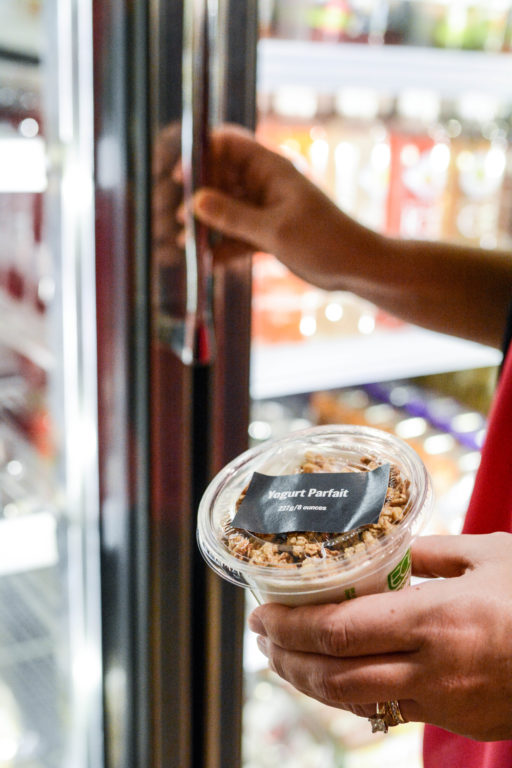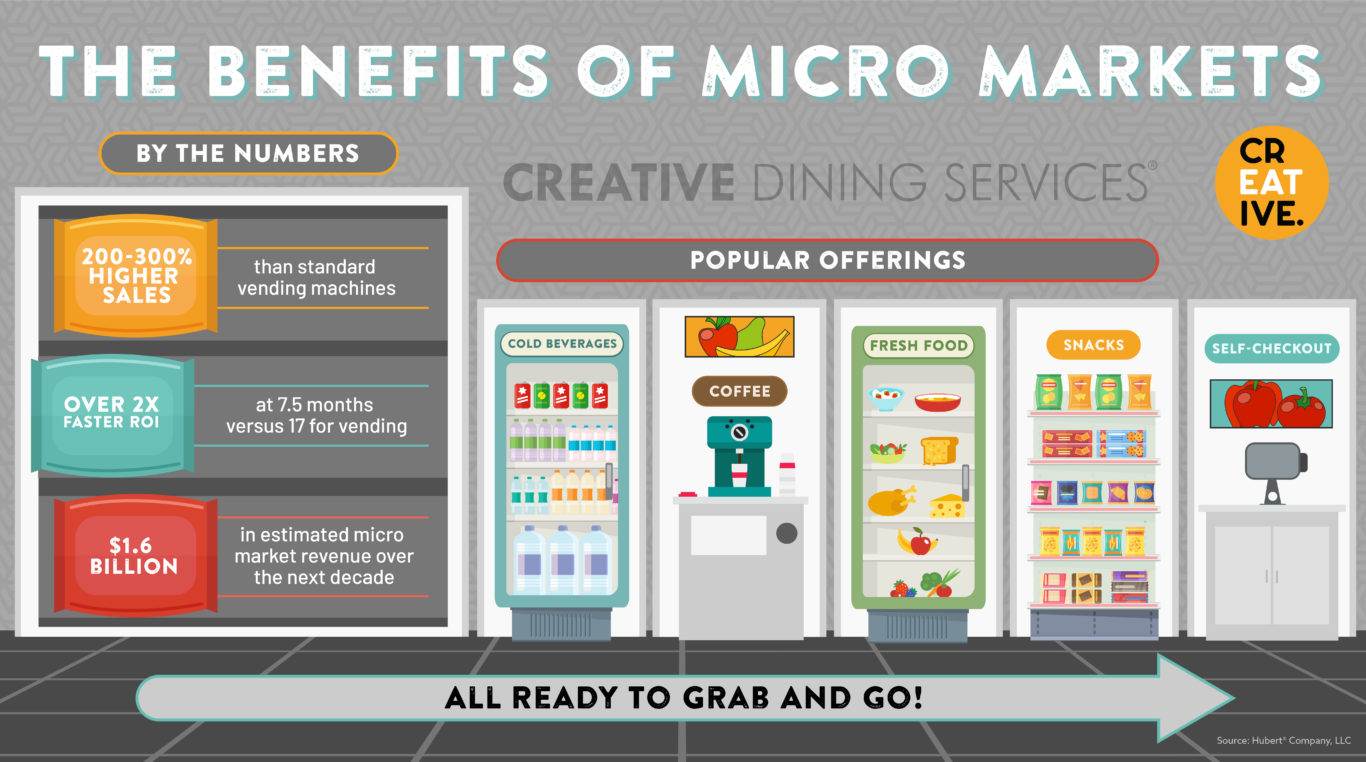Convenience isn’t just for convenience stores anymore! Employees and students want food when they want it, whether or not dining services are open. Whether it’s your third-shift staff or an athlete leaving a late practice, accessibility to flavorful food made with fresh ingredients is key.
If you’ve ever used the self-checkout lane, you’ve already experienced a larger-scale version of a micro market. These small, customizable retail spaces can carry food, snacks, various beverages, merchandise, and more. Many micro markets use a variety of coolers, refrigerators, freezers, and open shelving to offer a wide variety of goods.
With advances in technology, including self-checkouts and unobtrusive monitoring devices, unmanned market spaces are more feasible than ever. Here are a few ways we are using micro markets to increase flexibility and streamline high-quality dining experiences.
1. Convenience
We’re increasingly a population on the move, and efficiency is the name of the game. We have places to go, things to do, and only a limited time to do it. Convenience and expediency are equally important. Many lunch-goers will choose quick service over quality food, but with micro markets, they can have both.
Businesses may find that the lunch rush is the only time that warrants a full kitchen staff, but employees may work through lunch or want a healthy snack in the afternoon. Micro markets can fill that need. At colleges and universities, students may have classes, jobs, or activities during normal meal hours and need to grab a bite later in the day. With a micro market, there’s still access to fresh salads, sandwiches, and even noodle or grain bowls at all times of the day.

2. Healthy Variety
You might be wondering, “How is a micro market different from a vending machine if they both offer 24-hour access to food?” The answer is the quality and freshness of the food. Micro markets can offer traditional grab-and-go options like chips, but they can also operate as an extension to the lunchroom or dining hall. These markets have additional food options that dining teams made fresh that day.
For Creative Dining clients looking to implement a micro market into their dining services, we can quickly and easily set them up with one of our “Creative Good To Go” micro markets. These markets strike a balance: diners find their favorite chips and grab-and-go drinks, and they have additional food options that were made fresh that day. For example, made-from-scratch hummus bowls with tahini-dusted roasted vegetables and grilled chicken, or honey and peach Greek yogurt parfaits topped with crushed almonds.
Diners could grab a bag of potato chips and a can of soda from a vending machine, or they could grab a fresh, nutritious option like a chipotle chicken wrap, garden salad, and kombucha from a micro market.

3. Reduced Operating Costs
One of the greatest barriers to all-day-all-night dining is staffing. The volatility of the labor market makes self-checkout markets more affordable, easier to manage, and easier to budget for long-term. Unmanned markets make scheduling easy because, really, they don’t involve any.
Because micro markets only use self-checkouts, there’s no reason to have team members manning the market itself. Most markets don’t even require hiring more team members to stock them. We’ve previously offered part-time dining staff more working hours to expand their responsibilities into micro market stocking, with many eagerly accepting the new role. That means you can expand food service offerings and flexibility without increasing labor costs.
4. Inclusivity & Safety
Just because all diners need easy grab-and-go food doesn’t mean they all have the same food needs. Vegan. Halal. Kosher. Gluten-free. We take dietary restrictions of all kinds very seriously, both in dining rooms and through micro markets.
Micro markets allow for food segmentation on different shelves, in different coolers, and in individual packaging. They can be prepared in kitchens specialized to individual needs for options that are inclusive to everyone. In our “Creative Good To Go” markets, each freshly-made food item is marked with an individually-printed label highlighting ingredients, nutrition facts, and any potential allergens.
5. Food Waste Reduction
We’ve talked in the past about the importance of reducing wasted food, and this is a perfect example of one way to do so. Some of our clients may end up with extra vegetables, fruits, herbs, and spices not used in preparing food for the day’s lunch rush. They can add items like leftover peppers, tomatoes, spinach, and quinoa in a yummy salad with a homemade vinaigrette dressing.
Producing food for micro markets in-house allows the kitchen to repurpose those unused fresh ingredients into deliciously accessible foods for micro market visitors. This reduces the amount of food that goes into composting or landfills while also making the most of culinary budgets.
Choose Small Spaces With Big Impact
Micro markets can fit in the exact same space as a couple of vending machines while offering better variety, quality, and impact. It’s repeatedly shown that micro markets increase revenue and reduce labor costs with automated self-checkout service points that give employees, students, and diners what they want most: more flexibility.
If you’re wondering if a micro market is the right choice for your organization, reach out to us.
We’d love to chat about your flexible dining needs!




